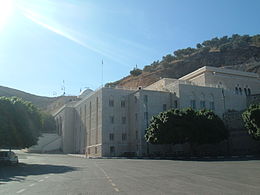Nabi Shuʿaib
Nabi Schuaib , also Neby Shoaib ( Arabic مقام النبي شعيب Maqam an-Nabi Shuʿaib , DMG Maqām an-Nabī Shuʿaib 'Place of the Prophet Shu'aib'), is a Druze and Muslim religious shrine (mazar / maqam ) near Kfar Zeitim and the depopulated Arab village of Hittin near Tiberias , Israel . It is said that the tomb of the Druze and Muslim prophet Shu'aib , who is traditionally identified with the biblical figure Jitro , is located there. Shu'aib is the fourteenth prophet in Islam .
history
In Muslim and Druze tradition it is said that at the end of his life Schuaib found refuge in a cave outside of Hittin, where he died in old age. His heirs buried him in the square and placed a tombstone on the square. Another tradition says that Saladin had a dream the night before the Battle of Hattin against the Crusaders . An angel promised him victory on the condition that after the battle he would ride his horse west. Where the horse stopped, the angel instructed him, he would find the tomb of Shuaib. After the dream came true, the Druze built the shrine in this place.
The shrine was expanded over time. The oldest parts of the current building date from the 1880s after a Druze spiritual leader, Sheikh Muhanna Tarif from July, made an appeal in the region to expand the shrine. A delegation of dignitaries traveled to Syria and Lebanon to collect donations, and the Druze from Galilee and Carmel also raised considerable funds.
When Palestine became a British Mandate , a dispute arose between the Druze and the Higher Islamic Council over who should be guardian of the shrine. After Israel was founded in 1948 and after the village of Hittin, previously inhabited mainly by Sunnis , was depopulated during the Palestinian War, the Druze were given full responsibility for the shrine and an additional 100 dunams of surrounding land. Under the leadership of Sheikh Amin Tarif , the shrine was renovated and some guest rooms for pilgrims were added. The Israeli government also paved the road to the shrine and laid electrical wiring and water connections.
Pilgrimages
The first mention of the tomb goes back to the 12th century and the Druze have celebrated pilgrimages ( ziyarat ) here for centuries . According to tradition, a footprint of Shuaib ( da'sa ) can be seen on the grave. Pilgrims pour oil into the hollow and then rub the oil on their bodies to ask for luck. Many people associate this with taking oaths ( nidhr ).
Originally there were no fixed dates for the annual pilgrimage, which was usually held in spring. When the Israeli government officially recognized the pilgrimage as a Druze festival, the dates were set. Today the pilgrimages take place between April 25th and 28th. Mass events take place during the festivities and religious leaders gather to discuss religious issues. Before Israel was established as a state, Druze also came to the festival from Syria and Lebanon , but this is no longer possible at the moment.
In the Levante distributed, there are other shrines for Nabi Shu'ayb.
See also
Web links
Individual evidence
- ↑ a b c d e Dana, Nissim. (2003). The Druze in the Middle East: Their Faith, Leadership, Identity and Status, in the Google Book Search Sussex Academic Press, pp. 28-30.
- ↑ Mahmoud Yazbak, Holy shrines (maqamat) in modern Palestine / Israel and the politics of memory. In: Marshall J. Breger, Yitzhak Reiter, Leonard Hammer (ed.), Holy Places in the Israeli-Palestinian Conflict: Confrontation and Co-existence, in the Google book search Routledge 2010 p. 231–246 p. 241.
- ↑ a b Kais Firro The Druzes in the Jewish State: A Brief History, in the Google book search BRILL, 1999.
Coordinates: 32 ° 48 ′ 27.7 " N , 35 ° 27 ′ 18.3" E




